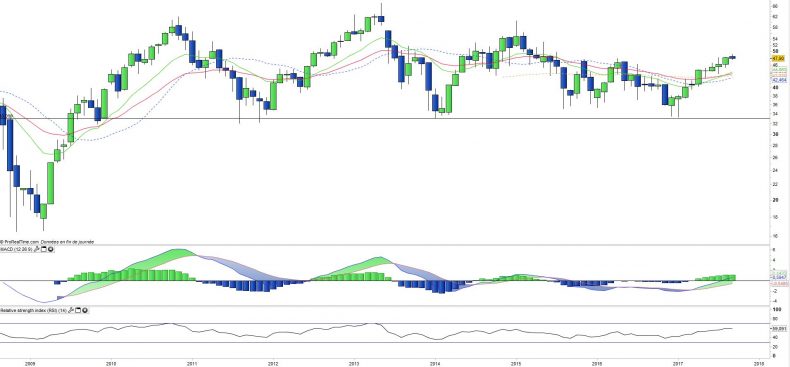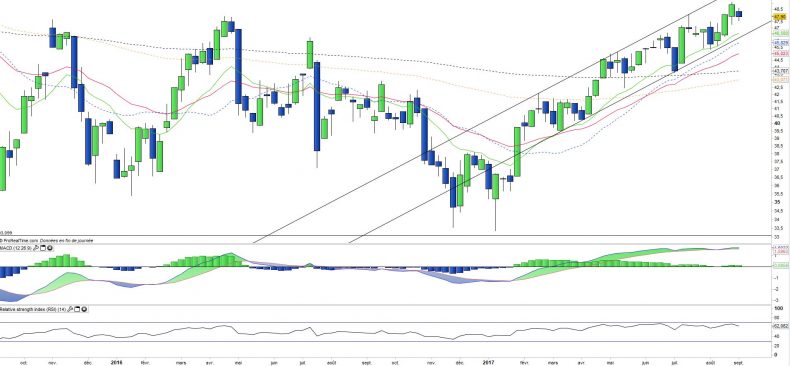Lyxor ETF Turkey - TUR - 06/09/2017
Short term Strategy : Positive (100%) / Trend +
Long term Strategy : Positive (100%) / Trend +
Characteristics of the ETF
Characteristics of the ETF
The ETF TUR (Lyxor), created in 08/2006, replicates the Dow Jones Titan index of the 20 largest Turkish stocks with the largest capitalization and liquidity. The method of calculating the index limits the weighting of each securities to 15%. The ETF's expenses are quite high compared to the average of our sample and reach 0.65% while the AUM amount to 113M €. The replication method is indirect (via a swap) and dividends are capitalized.
Index & components
TUR replicates a narrow index that is highly dependent on the financial sector which accounts for 43% of the capitalization, while industry is the second sector with 16%. The index will therefore be highly correlated with the Turkish economy, while energy represents only 6% of the index. This tracker embarks the risk related to the Turkish lira, which can be quite erratic.
After a double-digit growth for several years, the Turkish economy, which recorded a GDP of $ 720bn (17th in the world), slowed down due to the unfavorable international environment: weak growth in the euro area, US monetary policy, the Russian recession and the conflicts in Iraq and Syria. In addition, there have been political and security tensions within the country that have resulted in an authoritarian drift by President Erdogan leading to a considerable repression in the public and private sphere and could have long-term consequences.
The Turkish economy grew by 2.9% in 2016, a higher than expected figure, in a difficult political and security context, but well below the 6.1% recorded in 2015. public debt and deficit are low, but inflation remains above the 5% target set by the Central Bank. The outlook for 2017 is a further limited drop in growth at 2.5% due to political and international tensions and the exit of foreign investors, not to mention tourism, in free-fall after the wave of attacks at the end of 2016 and in the wake of repression measures.
Depending on imports of intermediate goods for its production, Turkey has a trade deficit, despite continued growth in exports, which have relatively low added value. The country suffers from the weak recovery in the euro area, a destination for a third of Turkish exports, and the political instability of the countries of the Middle East. The spearheads of Turkish foreign trade are the automotive and textile industries. Next, the agri-food, machinery, electronics, iron and steel and chemical industries.
The European Union is by far the largest customer in Turkey, followed by the United States, China and Iraq. Historically (since 10 years), this tracker is stuck within a large trading range between 15 and 60 € and an axis of symmetry around the level of 32 €. Volatility is not historically significant, which does not prejudge the future.
Latest developments
President Erdogan has greatly strengthened his powers after winning his referendum, and is rapidly moving away from Europe through the continual repression in the country and the total loss of independence of the judiciary and the media. A. Merkel has just confirmed the rupture with Turkey during an electoral debate and announced the end of the process of accession to Europe, which will have to be confirmed later on by a vote of the members of the union. The question now is whether Europe and Turkey will try to preserve their economic cooperation and military alliance via NATO, or whether the situation will continue to escalate.
Europe is Turkey's main economic partner, which in turn has helped to contain the inflow of Syrian refugees into Europe, so it is reasonable to expect trade and bilateral agreements to continue. On the other hand, European investment and tourism are expected to be less dynamic in the future. However, TUR has risen 27% since the beginning of the year, and has benefited from a rebound in the economy in recent months. The whole question is about the sustainability of this trend.
Monthly data
The monthly chart shows a long-term trend that is returning positive after boucing back on the long-term support set in the € 30 zone and broken out the downside line active since 2013. The MACD has crossed upward and is also passing the zero line.
It is fairly likely that the prices are now moving towards the top of the trading range located in the area of 60 € and which corresponds to the previous peaks.
Weekly data
On the weekly chart, we can observe a very solid medium-term trend that has been evolving in a rising channel since the beginning of the year. The rise is steady and without volatility, with very shallow consolidations.
The oscillators are oriented upwards but have tended to flatten for several weeks, which is consistent with a gradual upward continuation.
Objectifs de l’ETF
TUR is a UCITS compliant ETF that seeks to track the benchmark index Dow Jones Turkey Titans 20 TR (20 companies)
Characteristics
| Inception date | 11/08/2006 |
| Expenses | 0,65% |
| Issuer | Lyxor |
| Benchmark | DJ Turkey Titans 20 |
| Ticker | TUR |
| ISIN | FR0010326256 |
| UCITS | Yes |
| Statut EU-SD | Out of Scope |
| Currency | € |
| Exchange | Euronext Paris |
| Assets Under Management | 114 M€ |
| Dividend | Capitalisation |
| PEA (France) | No |
| SRD (France) | Yes |
| Number of Holdings | 20 |
| Risk | 4/5 |
Country Breakdown
| Turkey | 100% |
Sector Breakdown
| Financials | 43% |
| Industrials | 16% |
| Consumer Staples | 11% |
| Materials | 10% |
| Energy | 7% |
| Consumer Discretionary | 6% |
| Telecom services | 5% |
| Others | 3% |
Top Ten Holdings
| Turkiye Garanti Bankasi | 10% |
| Akbank TAS | 10% |
| Koc Holding AS | 9% |
| Bim Birlesik Magazalar AS | 9% |
| Eregli Demir Ve Celik Fabrik | 7% |
| Tupras Turkiye Petrol Rafine | 7% |
| Haci Omer Sabanci Holding | 7% |
| Turkcell Iletisim Hizmet AS | 5% |
| Turkiye IS Bankasi-C | 5% |
| Turkiye Halk Bankasi | 5% |


